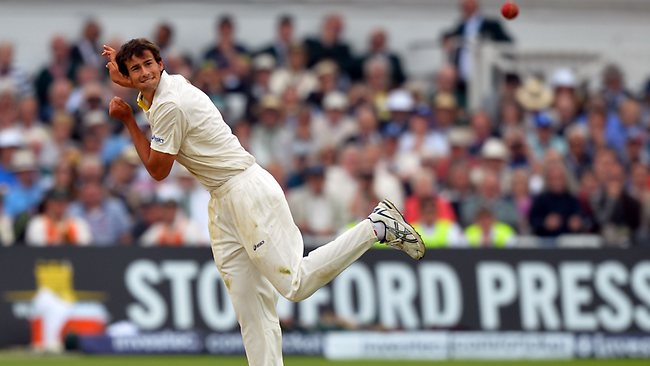Why England couldn't cope with Ashton Agar
BOY-bowler Ashton Agar’s demolition of one of cricket’s most potent bowling attacks was like walking round the block and then strolling up Everest.
THESE days the sightscreens at big-time cricket are like Venetian blinds: a line of slats that can twist one way to be one thing and another way to be something quite different.
Magic, really. When the bowling's from this end they are a plain slatted white, but when it's from the other, each particular slat swivels round and it becomes an advert. Last time I was in Australia it was white one way and Shane Warne eating a hamburger the other. At Trent Bridge it shifts from virginal purity to an incitement to cider-drinking.
The pitch at this match seems to be constructed on the same principle. Or perhaps it's the scrambled minds of the teams taking part, two bodies of men consistent only in their inconsistency. Or maybe it's just the plot.
But quite certainly, that's the way things are working out. One minute it's this kind of match, next minute it's that kind of match; one minute it's one kind of team, next minute it's another kind of team. Perhaps some kind of order will emerge, but overnight mere anarchy was loosed upon Trent Bridge.
PICTURE GALLERY: Agar's amazing innings
I might have explained Australia's collapse, but not with their subsequent uncollapse. I might have explained England's passage of dominance, but not their equally sudden passage of humility. How could one follow another with such speed? It's beyond analysis.
Perhaps only sport can do this; sport when played with such mad intensity that the participants can hardly remember who they are from one over to the next.
The Australians began the day by slapping the ball around as if batting were the easiest thing in the world, especially against this bunch of pie-chuckers. For the first half-hour of play it looked as if they'd be doing it all day and half the next.
Then - switcheroony! - they lost five wickets in half an hour while scoring nine runs: from 108 for four to 117 for nine.
Ha, I thought. At last English superiority has asserted itself. Wednesday was one of their funny days but now they've found their real selves and taken control. Ruthless, brilliant: Jimmy Anderson, Graeme Swann, Australia batsmen frantically strapping on pads and taking them off again, England in complete mastery.
Switcheroony!
Yes, just like the sightscreen. From batting collapse to bowling collapse. And with it came the astonishing innings of the 19-year-old Ashton Agar: calm, assured, confident, inspired, with Phillip Hughes supporting bemusedly from the other end. They put on 163 runs for the last wicket, 98 of them to Agar, and all without an atom of luck - unless you count that stumping chance, which Agar was given the benefit of the doubt on - or a hint of a slog. There have been sizeable last-wicket stands before, even if not as big as this. But seldom have they made such a devastating contrast with what went before.
Australia went from craven to magisterial, while England made a reverse journey from rampant to impotent in the space of a few balls. It was like a dream, nightmare or the other kind, depending on who was doing the dreaming.
For Agar it was flying under his own power and the impossible is suddenly effortless; the England bowlers were running from the Daleks with their feet in treacle.
This just couldn't be happening. You just can't step into Test cricket as a No11 boy-bowler and destroy one of the most potent bowling attacks in world cricket. It's like walking round the block and then strolling up Everest; it's like cooking beans on toast before cooking a meal in a Michelin-starred restaurant; it's like playing Chopsticks with Beethoven's piano concerto No5 as your encore.
Everybody knows that it can't be done; and that was why England couldn't cope with it. A fault in reality, a rip in the fabric of space-time, while that lanky galoot just went on and on like Old Man River, one marvellous stroke following another.
It was sublime. It didn't feel real, but it felt as if it was never going to stop. Only the insuperable barrier of three figures halted his flow, and perhaps only 11 men were glad that it did.
This innings was remarkable enough as it stood. It was doubly so in the context of a collapse so complete that it reminded you of England in their finest hours. Nor was it one of those gallant efforts that look good in the stats book but mean little in the context of the match. Agar's knock took Australia from a point of near-certain defeat and left them as the team dictating terms.
Agar might have turned the five-match series or the entire ten-match double series of this relentless back-to-back schedule, but this match and especially this day have been too crazy for firm conclusions.
Everything that followed Agar's innings was an anticlimax. England lost two wickets in two balls, after which Alastair Cook and Kevin Pietersen batted as if this were a timeless Test - which it sort of is, given that more than half the wickets had fallen by the time they came together with only a third of the match's 15 sessions played.
It was a remarkable, bewildering day, a case-book example of the effects that high-octane sport has on the human brain, alternating inspiring and scrambling in ways that defy logical analysis.
Here are my conclusions after the day's play: England are, (a), terrible and , (b), brilliant. And so are Australia.
The Times






